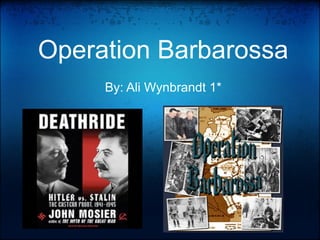
Operation Barbarossa
- 1. Operation Barbarossa By: Ali Wynbrandt 1*
- 2. Background Information - Operation Barbarossa was the name for the German invasion of the Soviet Union during World War II. - Germany wanted to invade the Soviet Union because they needed more raw materials, and there was growing tension between Germany and the Soviets because of a potential collision between Hitler and Stalin over the Balkan region. - The operation was named after Emperor Frederick Barbarossa of the Holy Roman Empire, who led the third crusade in the 12th century. - It was the largest military attack of World War II.
- 3. Preparations for the Invasion - Hitler referenced an attack on the Soviet Union in Mein Kampf, which worried Stalin of a possible German invasion - Stalin wanted to postpone the war with Germany so they could prepare by building a bigger and stronger army with heavy artillery. - Hitler began placing troops near the Soviet border well before the attack. - Hitler ordered aerial surveillance of Russia before the attack to spy on the Russian army preparing for war. - Hitler read about Napoleon's invasion of Russia and began to make a strategy to avoid the same mistakes Napoleon made.
- 4. The Attack - Hitler attacked Leningrad and Moscow in the north, and Ukraine and to the west of Kiev in the south, and eventually on to Stalingrad. - The attack began on June 22, 1941 with the Axis powers bombing Soviet troops in occupied Poland. - After that, the Axis powers began the campaign on the eastern front with 3.2 million German troops and hundreds of thousands of other Axis troops joining them in the attack against the Soviets. - The Luftwaffe spied on Soviet troop positions and they were supposed to counter the Soviet air force. - As the Soviets retreated, they would burn down everything (factories, farms, etc.) that could help the Axis powers. - Although the Axis powers celebrated early victories, they underestimated the Soviets, and the Soviets came back with a huge counterattack, which pushed Hitler out of Moscow and back 200 miles. - The best weapon that let the Soviets defeat the Axis was the harsh Russian winter, which had forced hundreds of thousands of Axis troops to stay in Russia during the winter months and wait it out, which was very valuable to the Soviets. - Operation Barbarossa eventually failed and was one of the bloodiest battles in history.
- 6. Statistics Axis Powers Soviet Union - 3.9 million troops - 3.2 million troops (initial) - 3,600 tanks - then 5 million more troops - 4,389 airplanes - 12-15,000 tanks - 46,000 artillery - 35-40,000 airplanes - 250,000 killed - 800,000 documented lost - 500,000 wounded troops, later estimated at 7 - 25,000 missing million - 2,093 airplanes destroyed - 3 million wounded - 2,758 tanks lost - 3,300,000 captured - 21,200 airplanes lost - 20,500 tanks lost - 20 million civilians lost
- 7. Importance in WWII Operation Barbarossa played a big role in the play-out of WWII. This attack on the Soviets brought them into the war on the side of the Allies. It also gave Hitler his first major blow of the war when he could not capture Moscow. After that, Hitler never regained his strength and ultimately led to his demise. All in all, this event was very important to the way the rest of the war played out.
Notas do Editor
- \n
- \n
- \n
- \n
- \n
- \n
- \n
- \n